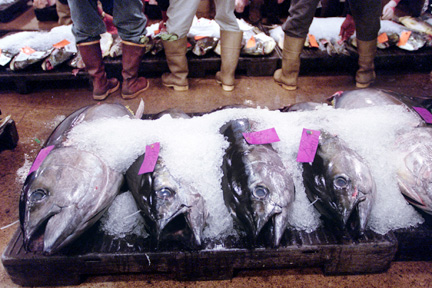Popular tuna is
being overfished
An American council has set
guidelines that it hopes other
countries will follow
The council responsible for managing the fisheries of the western Pacific Ocean has come up with an initial plan to help prevent overfishing of bigeye tuna, a favorite of Japan's sashimi market.
Only about 5 percent of the bigeye tuna harvested from the Pacific is caught in the U.S. Exclusive Economic Zone -- the waters between three and 200 miles off the coasts of Hawaii, American Samoa and the Northern Mariana Islands.
In December the National Marine Fisheries Service notified the Western Pacific Regional Fishery Management Council that bigeye tuna is being overfished, and ordered the council to come up with a plan by June 14, when the council will next meet, to address overfishing.
Although the council's initial plans, approved unanimously at its meeting this week, are only enforceable within U.S. waters, the council included recommendations for foreign vessels as well.
The council's plan would require Hawaii's small-vessel, offshore tuna handline fishery to keep logbooks, place limits on the number of boats fishing when necessary, and place observers aboard some boats.
"This would require both domestic and international action," said Marcia Hamilton, an economist with the fishery council. "We cannot force foreign nations to do things.
"The idea was to get our own house in order," she said.
The council noted that the Inter-American Tropical Tuna Commission, which regulates the Eastern Pacific, has already ordered the longline vessels fishing for tuna to limit their catch sizes to 2001 harvests for last year, this year and 2006.

The National Marine Fisheries Service notified the Western Pacific Regional Fishery Management Council in December that bigeye tuna, which is in high demand in Japan, was being overfished. Above, bigeye tuna are on display at the United Fishing Agency.
"In the Eastern Pacific, the populations are below for the maximum sustainable yield, and consequently the IATTC has taken action to restrict the fishery," said Robin Allen, of the Inter-American Tropical Tuna Commission based in La Jolla, Calif.
Its counterpart, the Western and Central Pacific Fisheries Commission, only recently formed and has not yet issued restrictions.
Hamilton said the Western Pacific council is working on quantifying the goal of the initial recommendations.
"We know there is too much fishing, but what is the appropriate amount of fishing?" she said. "We don't seem to know that answer."
Hamilton said another point is to focus on managing how many vessels are fishing and how many hooks are in the water as opposed to managing how many tons of tuna are taken from the ocean.
The Pacific once supplied two-thirds of the global tuna catch of 4 million tons a year.
Bigeye tuna is one of four types of tuna caught in the western and central Pacific, and one of two already considered to be overfished. Yellowfin tuna, the second most popular variety for canning, is nearing full exploitation, but skipjack tuna, the largest source for consumption as "light tuna" in cans, and albacore tuna, the "white tuna" of cans, are not overfished.
www.wpcouncil.org/about.htm
Western and Central Pacific Fisheries Commission
www.ocean-affairs.com
Inter-American Tropical Tuna Commission
www.iattc.org/HomeENG.htm
[News] [Business] [Features] [Sports] [Editorial] [Do It Electric!]
[Classified Ads] [Search] [Subscribe] [Info] [Letter to Editor]
[Feedback]
